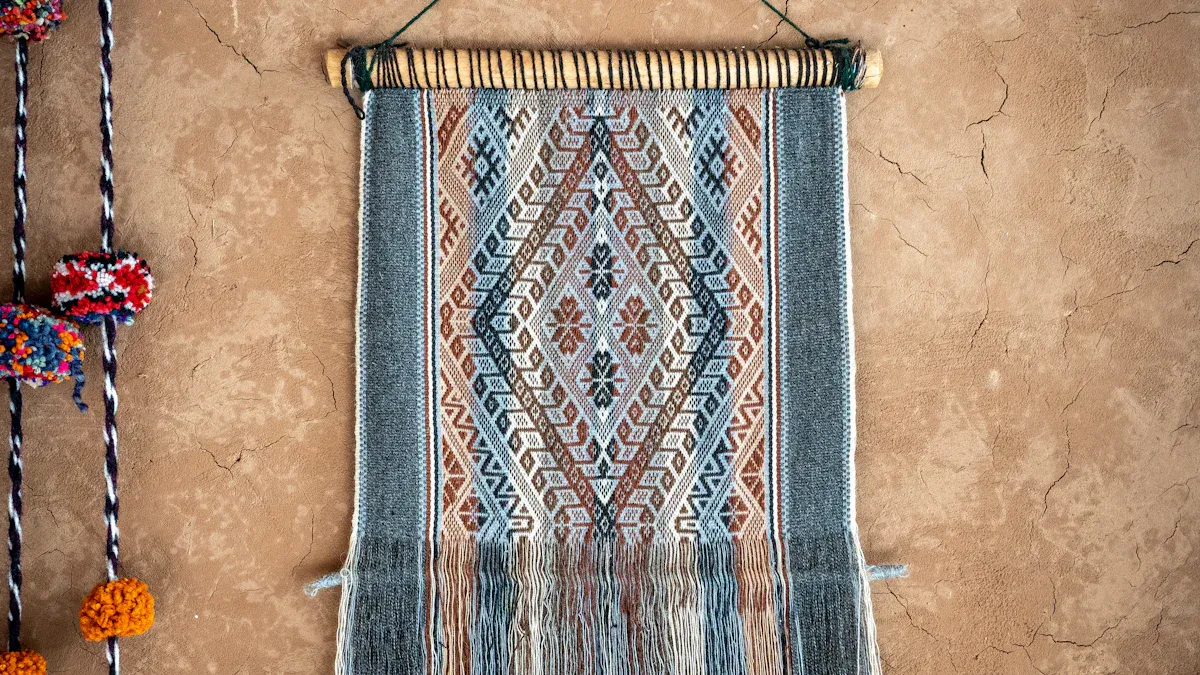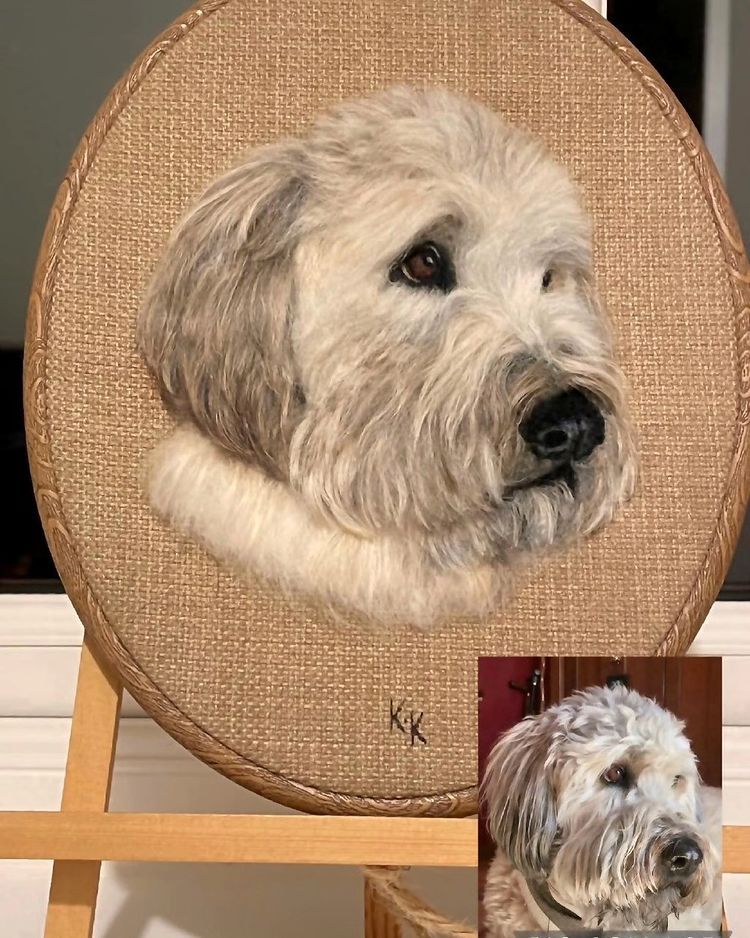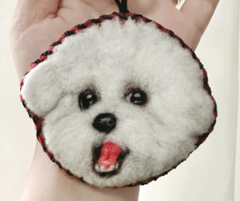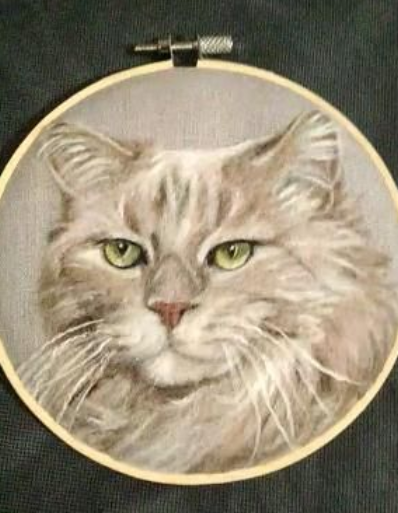What is needle felt painting and how does it stand apart from other fiber arts

Needle felt painting lets you use wool fibers and a special barbed needle to make pictures that look like paintings. You can create lifelike portraits of your pets. You can also design colorful landscapes to show your creativity. This art form is part of fiber art. In fiber art, artists use things like wool, yarn, and fabric to make special pieces. Today, you can show your finished art in new ways. Digital photo frames have clear HD screens. They change brightness to match the room, so your art always looks great. You can upload your own fiber art and make a personal gallery at home. This makes every memory and moment feel special.
Key Takeaways
Needle felt painting uses wool and a special needle. You can make detailed pictures with it. This lets artists show their own style in a new way.
This art lets you save memories, like of your pets. You can make portraits that look real and mean a lot to you.
You can show your needle felt paintings in many ways. You can put them in frames or use digital photo frames for a cool look.
Needle felting is easy to try and does not cost much. You only need simple things like wool, needles, and a mat to start.
Needle felting feels good to do and helps you be creative. It is a fun hobby for people with any skill level.
Fiber Art Overview

Common Types
Fiber art is made in many places. Artists use both real and fake fibers to make pretty art. Fiber art is about how the piece looks and feels. It is not just about what it does. The main types are string work and felt work. String work uses spinning, knotting, lace making, weaving, and needlework. Felt work has sculpture, string felt, fur felt, wet felting, and dry felting.
Here is a table to help you see the main categories and their techniques:
Category |
Techniques |
|---|---|
String work |
Spinning, knotting, lace making, weaving, needlework |
Felt work |
Sculpture, string felt, fur felt, wet felting, dry felting |
Techniques
There are many ways to do fiber art. Each way lets you use wool and other fibers differently. String work has weaving, knitting, and crochet. These can be easy or hard. You can make a scarf or a fancy wall hanging. Felt work uses wet felting and dry felting. Wet felting needs water and soap to stick wool together. Dry felting, or needle felting, uses a barbed needle to shape wool. Needle felting helps you make soft sculptures or pictures, like a pet portrait.
Here is a table showing some common techniques, their complexity, and what you can make:
Technique Type |
Examples |
Complexity |
Outcome |
|---|---|---|---|
String Work |
Weaving, Knitting |
Simple to complex |
Functional or decorative items |
Felt Work |
Wet felting, Needle felting |
Usually simpler |
Sculptures, art pieces |
Outcomes
Fiber art can give you many finished things. You can make things to use or to show. String felt is often used for warm mittens or hats. Fur felt makes hats that are soft and strong. Wet felting can make light cloth or bumpy felt. Art yarns add color and texture to your work. Macramé lets you make wall hangings and jewelry. Needle felting is special because you can make detailed art, like a pet portrait, with just wool and a needle. This way, you can save memories and feelings in a special form.
Type of Fiber Art |
Typical Finished Products/Outcomes |
|---|---|
String Felt |
Dense mittens, insulating items |
Fur Felt |
Soft, resilient hats |
Wet Felting |
Lightweight cloth, textured felt |
Art Yarns |
Colorful, textured skeins |
Macramé |
Wall hangings, jewelry |
Tip: When you use wool in needle felting, you can make art that means a lot, especially if you make a picture of a pet you love. This kind of fiber art helps you show feelings and keep memories close.
Needle Felt Painting vs. Fiber Art
Technique Comparison
Needle felt painting and other fiber arts use different methods. Needle felting needs a barbed needle to poke wool fibers. This makes the fibers stick together. You add layers of colored wool to make a picture. It is like painting, but with wool. Wet felting uses water and soap to join fibers. You rub and press the fibers until they stay together. Weaving and knitting use yarn and tools to make shapes or patterns.
Needle felt painting is special because you can use things like feathers or paper. These materials do not felt, but you can add them to your art. This gives you more ways to show your ideas. Most other fiber arts use only yarn or wool. Needle felting lets you make flat pictures and 3D sculptures. You can control how your art looks and feels.
Tip: Needle felt painting helps you show your pet’s personality. You can use layers of color and texture. This makes your art look real and full of feeling.
Materials Side-by-Side
Needle felt painting uses different materials than other fiber arts. Here is a table that shows the main differences:
Material Type |
Needle Felting Advantages |
Other Fiber Arts Advantages |
|---|---|---|
Wool |
Great for sticking together, keeps its shape well |
Natural, warm, and lets air through |
Synthetic Fibers |
Works well in dry felting, very flexible |
Strong and usually costs less |
Cotton |
Can be used in wet felting |
Soft, soaks up water, and easy to color |
You can buy basic felting supplies at craft stores. Wool is good for the planet because it breaks down and grows back. Synthetic felts are cheap and easy to find. But they can cause microplastic waste. Here is another table to compare cost, how easy it is to find, and how green each choice is:
Aspect |
Needle Felt Painting (Vegan Options) |
Traditional Wool |
|---|---|---|
Cost |
Usually cheaper for basic felt |
Can cost more for fancy wool |
Availability |
Easy to find in craft stores |
Often bought online |
Sustainability |
Synthetic felts can make microplastic waste |
Wool is renewable and breaks down |
Pick the material that works best for you. Wool is soft and lasts a long time. Synthetic fibers are good if you want to try something new or save money.
Artistic Results
Needle felt painting gives art a special look and feel. You can stack fibers to make depth and texture. Your finished piece can look like a real painting. The surface is soft and you can touch it. You can shape and add details easily. This helps you make lifelike portraits or sculptures.
Other fiber arts, like weaving or knitting, make flat or patterned pieces. These look nice, but may not have as much detail or texture. Wet felting makes soft shapes that blend together. But you cannot control small details as much.
Here is a table to compare the results:
Aspect |
Needle Felt Painting |
Other Fiber Arts |
|---|---|---|
Visual Quality |
Layered and textured art |
May look flat or less detailed |
Textural Quality |
You can shape and control texture |
Less control in wet felting |
Material Incorporation |
You can add things that do not felt |
Usually only uses felting materials |
You can show your needle felt painting in many ways. You can put it in a frame like a painting. You can also use a digital photo frame, like Pawimprint. This lets you upload photos of your art. The screen is bright and clear. You can make a slideshow of your favorite pieces. This is a fun way to share your art with others. It helps you keep your memories close.
Note: Needle felt painting is a good way to turn your love for pets into art. You can show what makes your pet special. You can display your finished art at home or on a digital photo frame so everyone can see it.
Needle Felt Painting

Definition
Needle felt painting is a special type of fiber art. You use wool and a barbed needle to create pictures that look like paintings. This art form lets you build images by layering colored wool on a flat surface. You can make lifelike portraits of pets or beautiful landscapes. The process gives you control over color, texture, and detail. Many people choose needle felting to capture the unique personality of their pets. Each felted object can hold deep emotional meaning, making it more than just a craft.
Process
You can follow step-by-step instructions to create your own needle felt painting. The needle felting process is different from other fiber arts because you use a felting needle to poke and shape wool fibers. Here are the main steps:
Prepare your workspace. Choose a comfortable, well-lit area.
Pick your design. Use a photo or sketch as a guide.
Set up your felting surface. Stretch fabric in an embroidery hoop or use a foam pad.
Build the base layer. Place small pieces of wool, starting with background colors.
Add details and shading. Use different shades of wool for depth.
Blend colors. Mix wool fibers for smooth transitions.
Layer for dimension. Add more wool to create texture.
Refine your work. Check your reference and adjust details.
Add embellishments if you want. Beads or sequins can add sparkle.
Finish and frame your art. Trim extra wool and display your painting.
This process lets you create art that feels soft and looks real. Needle felting stands out because you can layer and blend wool in ways that other fiber arts do not allow.
Materials and Tools
You need a few key materials and tools for needle felting. The quality of your wool affects how easy it is to work with and how your finished art looks. Here is a list of what you need:
Wool (choose high-quality wool or cashmere)
Felting needles (single and multi-needle tools)
Felting mat or crafting foam
Roving wool in many colors
Embroidery hoop or foam pad
Finger protectors (optional)
Cookie cutters (optional for shapes)
Different needle types (size 38 star, size 40 or 42 triangle)
The right tools help you shape and blend the wool. Fine needles let you add small details. A good felting mat protects your workspace. Using the best materials makes your needle felting experience smoother and your artwork more vibrant.
Tip: Always store your finished needle felt painting away from sunlight. This keeps the colors bright and your memories safe.
Why Choose Needle Felting
Unique Qualities
Needle felting stands out in the world of fiber art because it gives you a special kind of control. You can shape your work exactly how you want. The barbed needle lets you move and blend wool with precision. You can add feathers or paper to your art, which is not common in other felting methods. This makes your creations unique and personal. The texture and layers you build with wool can look like a watercolor painting. Each piece feels soft and looks full of life.
Here is a table that shows what makes needle felting different:
Unique Quality |
Description |
|---|---|
Significant Control |
You can shape your art with great detail and accuracy. |
Use of Various Materials |
You can add things like feathers or paper to your wool art. |
Textured, Layered Scenes |
You can create scenes that look like paintings, with rich texture and depth. |
Needle felting also helps you connect with your feelings. When you make a pet portrait, you use wool to capture your pet’s look and spirit. This kind of art lets you keep memories close and celebrate the bond you share with your pet.
Creative Appeal
You can find many reasons to choose needle felting for your next art project. The creative process uses a barbed needle to shape wool, which lets you add layers and textures not possible in other fiber arts. You can follow a tutorial and finish a project on your first try. Many people say they feel proud and happy after making their first piece.
Needle felting gives you freedom. You can make simple shapes or detailed portraits. You can work on small or large projects. The supplies are easy to find and do not cost much. You only need wool, a needle, and a felting mat. You can take your tools anywhere and work on your art when you travel.
Here are some main reasons artists like you choose needle felting:
Reason |
Description |
|---|---|
You can control colors, shapes, and details in your art. |
|
Versatility |
You can make many kinds of projects, big or small, simple or complex. |
Affordability |
You do not need expensive tools or supplies. |
Portability |
You can carry your wool and needle anywhere. |
Satisfaction |
The process feels good and brings joy when you finish your art. |
Tip: Many tutorials are available for needle felting. You can learn new skills and finish a project quickly. People often say they feel happy and connected to their pets after making a wool portrait. This kind of artistic needle felting helps you express love and keep memories alive.
You can find a tutorial for every skill level.
Many people finish their first project with help from a good tutorial.
Tutorials often show you how to use wool and felting needles safely.
Needle felting is more than just a craft. It is a way to express yourself, remember your pets, and enjoy the art of making something by hand.
You can see how needle felt painting stands apart from other fiber art. You use wool to create pictures that feel soft and look real. Wool lets you blend colors, add texture, and shape every detail. When you make a pet portrait, wool helps you show love and keep memories close. You can use wool for backgrounds, shading, and highlights. Each layer of wool adds depth. Try showing your wool art in a digital photo frame. This way, you can enjoy your wool creations every day.
FAQ
What is the main difference between needle felt painting and other fiber arts?
Needle felt painting uses a barbed needle to layer wool and create detailed images. You can blend colors and add texture. Other fiber arts, like knitting or weaving, use yarn to make patterns or shapes.
Can you make a pet portrait with needle felt painting?
Yes! You can create a lifelike portrait of your pet using colored wool. Many people choose this art to capture their pet’s personality and keep special memories close.
What tools do you need for needle felt painting?
You need wool, felting needles, and a felting mat. Some artists use embroidery hoops or foam pads. You can also add beads or other small decorations for extra detail.
How can you display your finished needle felt painting?
You can frame your artwork or use a digital photo frame, like the one from Pawimprint. This lets you show your creations in bright, clear detail and enjoy them every day.

